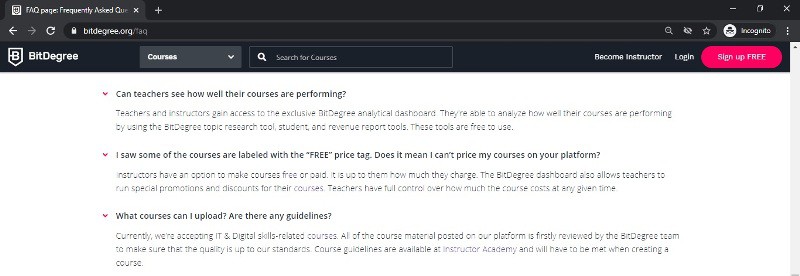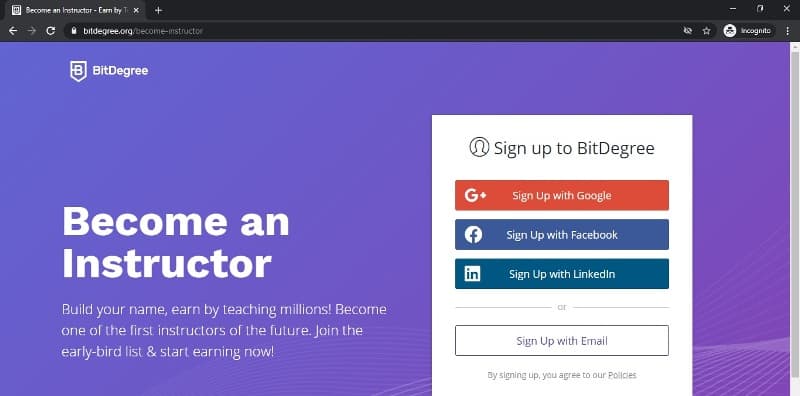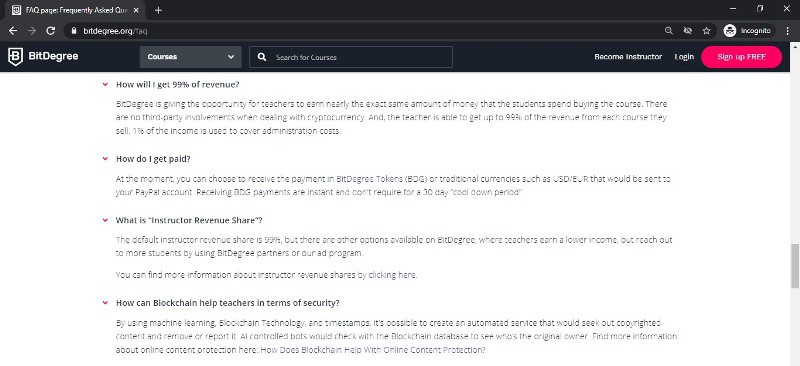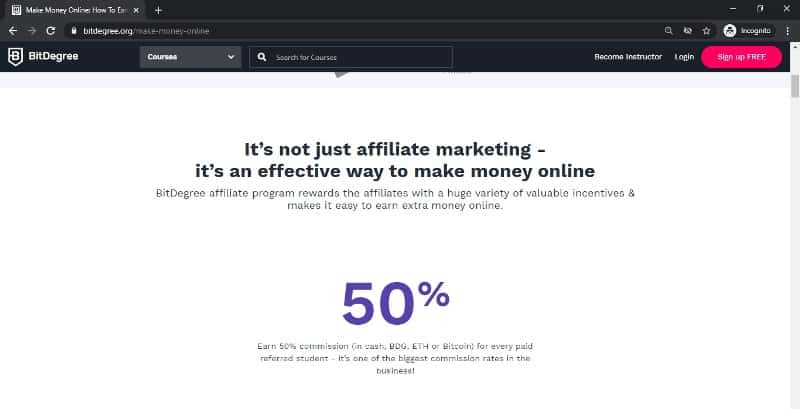Bitdegree Review Summary
What if there is a platform that incorporates unique fun factors in learning, would you feel interested to become part of it?
The things that Bitdegree offers are unique, fun and remarkable, so keep reading this Bitdegree review article so you’ll know if such opportunities are worth grabbing.
Bitdegree is the first of its kind as an internet-based education platform powered by blockchain. I find this platform’s game-like mode of learning to be very interesting for both students and teachers.
Blockchain refers to the more secure database allowing individuals to send/receive crypto currencies like Bitcoin. The online community, instead of a single person or entity, will verify and confirm all transactions.
Once confirmed, everyone can see the transaction on the Blockchain. Here at Bitdegree, they use Blockchain for issuing scholarships, for securing instructors’ videos and for providing certificates.
All the students’ achievements get stored on the Blockchain database. Any token reward that a student earned is exchangeable to digital services or goods.
What Makes Bitdegree Unique
In this video, the vlogger says that at Bitdegree, you could earn while you learn.
This “earn as you learn” opportunity makes Bitdegree unique and beneficial to students at the same time. They can exchange the token rewards they collected for additional courses or other currencies.
Students can start with free basic courses and then move onto paid advanced and premium courses.
Bitdegree connects companies to talented students who could be their future employees.
Companies and organizations (corporate, private, government, HR, etc) can create courses like experienced instructors, grant scholarships, and offer other rewards.
Students can participate in a game-like learning environment, which could keep them more engaged and motivated. Conventionalists might think it is impossible to combine learning with gaming, but Bitdegree has made this possible.
Through gamification of learning or by integrating the learning process with game mechanics, it created an e-learning environment that is more engaging and motivating.
The Bitdegree Difference For Teachers
Bitdegree offers a marketplace for the experienced instructors as it creates top quality interactive classes for students.
Bitdegree differs from other teaching or online platforms we have looked into so far, namely VIPKid, Chegg, Takelessons, Wyzant, Skooli, TutorMe, Preply, Tutor.com. Connections Academy, Superprof and iTutorgroups.
Aside from the blockchain database and e-learning gamification, other factors make it unique to tutors and teachers.
Let us start with what Figure 1 shows.

Figure 1
You see here that you will teach not through live one-on-one sessions, but through recorded video lessons. It has an interface that allows you to upload your content and provide all the information about your video.

Figure 2
Other platforms allow you to teach a wide variety of lessons from academic subjects to test preparations, hobbies, arts and even foreign language learning such as English.
Here at Bitdegree, the subject areas are related to IT and digital skills and limited to the categories of
- Blockchain
- Business
- Coding & Programming
- Community Votes
- Data Science
- Design
- IT Security & Software
- Marketing and
- Personal Development.
The Bitdegree team looks through each material before allowing the contents to become available on the platform.
Teachers or instructors will know how their courses are doing through the analytical dashboard with tools free to use.
As the platform offers a unique teaching setting, it requires some getting used to. Fortunately, Bitdegree offers tutorials and resources that first-timers could learn from.
You are a lecturer here at Bitdegree and you present your lecture digitally through a recorded video presentation.
Requirements
Now that you know what it means to be an instructor at Bitdegree, you probably already have an idea about what you need to become one and how you could perform your instructor duties.
Keep in mind that this is an online job so the basic tools are computer and internet connection. Below is a simple checklist to use, especially when it is your first time to record a lecture.
1) Lecture Outline or Script - You need the knowledge about the subject area or topic whose video lesson/s you want to record and upload to the
Bitdegree platform. It is from your mastery of your subject area where you will source ideas. From your ideas, you could prepare your flow of lecture and develop your script. Once the script is ready, practice your lines.
2) Lecture materials – for a traditional lecture that you would like to capture in a video, you might need a whiteboard and marker.
If you want to stick with digital presentation, you might still need to record your voice and then incorporate it in the slides. You may add downloadable resources in .doc or .pdf files.
3) Filming Venue - You need a quiet space for filming, choose a distraction-free wall that will reflect light well. Choose a room where there is minimal noise.
4) Lighting and Sound - Speaking of lighting, natural lighting is ideal, but you may use other light sources that will illuminate your face without creating distracting shadows.
For your sound or audio, you might need a good quality microphone or headset with a microphone that can cancel out noise.
5) Filming Equipment - You might need a camera or a camera with a smartphone. Arrange the recording setting to the highest possible setting, such as 720p and 16:9 vide type.
Choose MP4 for the video format. Set up the camera on a tripod or on a solid surface where it can capture you and your voice well. Do a test recording while you practice your script.
Make sure you look straight to the camera and speak audibly.
6) Recording Slides – These slides with talking head or voiceover are for instructors who have more advanced editing skills for combining several sources of content in one video.
You may use slides and then place a video of you (narrating/explaining the slides) at the corner of the screen.
Course Creation
Once a registered instructor, you may access your profile and create your course in the Instructor area or studio. Begin by giving your course a title.
Add a school name, subject name and class name to your content so it will not get mixed with the other video lessons of similar subjects.
They recommend that you divide the educational material into sections per topic. This way, there will be a structure that can guide the students. Give each section a title that contains a date or timeline.
This will help students immediately see if they have finished a particular section or not.
1) Video Length - The most common lectures are 3-10 minute of video content. This makes for faster uploading and more effective online viewing. You can briefly introduce an important point as you encourage the student to move to the next video.
2) Video Content – While a video recording of you talking and explaining the lecture is good, it is better to make use of graphics that will somewhat break the ice.
You can add text lessons into your lectures. I think this is great because sometimes viewers might prefer reading texts rather than listen to the audio or narration in a video.
In the “Article” section, you may add graphics and illustrations and then embed external videos.
The goal is to provide more elements into your lecture to make it more engaging. You could also go to the “Input” section and create a quiz to test your students.
This “Question Groups” is the option for creating distinct sets of questions. A student will answer randomly selected questions. This allows for course diversity and decreased possibility of cheating.
All at once, you can also add various questions and opt to only show some of them at random.
3) Visibility – “Public” visibility makes the course visible to anyone. “Secret” visibility option is for making a course accessible only to those who have the link to it.
“By Invitation Only” visibility option is for making a course visible only to those whose email addresses you specify.
4) Category – Choose “Interactive Learning” for the course category.
5) Language – English is the language choice if you want the course to be on the main platform of Bitdegree.
6) Skill Level – “Beginner” is for first-year students. “Intermediate” if the course is for middle year students and “Advanced” if the course is for the senior students.
7) Course Thumbnail – You may set up your own thumbnail or let the Bitdegree team draw it for you.
8) Course Description – The required word count for “public” courses is 300 words while “secret” and “by invitation only” courses may not have descriptions.
9) Course Tags – This should include the school or university name, subject name, class year/name that will help students find your course.
10) Other Requirements of The Course – There are lessons where a student would need to use other tools or materials while taking your course, such as calculators or even past knowledge or familiarity with a specific topic.
11) Course Goal – You should add the focal points that the students ought to learn while taking the course.
12) Pricing – Keep in mind that basic lessons are free. For example, you are an instructor at a certain institution, you may join Bitdegree as an instructor and create free courses here that your students may take.
If you will upload a paid course, you may offer promo codes to attract potential students.
The Support Team will review your submitted course to make sure it is okay to publish.
Student Tracking
As an instructor, you would want to know the efficiency of your course and how students perform. Bitdegree offers simple student tracking through the Student List.
Apart from the student name, this list also shows
- The Time Spent (who completes the lesson quickly and who takes longer at it)
- Completion (how many items the students completed) and
- the Assessment Score (how the students performed in the quizzes you added to the course).
This tracking system will help you have an idea whether your course is effective.
For example, the Completion data will tell you if there are students with few completed items. You may take it as a signal to reach out to that student and make suitable clarifications.
Another way to track students is through the Stats page. You can see
- where your students are from
- the number of students
- number of enrolees
- who have completed or are still taking the courses
- the average scores
- average progress and
- the time spent by the students.
Bitdegree Instructor Key Points
To do well as a Bitdegree instructor, there are some important matters to keep in mind.
1) A teacher is a student first. This is a given, but really applies to the fact you must also do your homework before you make and sell courses.
This means you should first research and choose a topic you love or are familiar with; a topic that students will find beneficial.
2) Preparation is the key. This covers the tasks of planning, making the script and outlining the courses. It is like making a lesson plan, which you probably already have if you used to teach in a real life education institution and would like to switch online due to the pandemic.
How To Apply
To sign up as an instructor, visit https://www.bitdegree.org/become-instructor. The image below shows a screenshot of the sign up page.

Figure 3
There are different ways to sign up: via Google, via Facebook and via LinkedIn. You may also sign up by providing your email address.
Potential Income
An instructor’s salary comes from the sales of his courses. Look at Figure 4.

Figure 4
Instructors may earn almost all the money that the student paid for the courses they avail. However, Bitdegree takes 1% from the sales to cover the administration expenses while 99% goes to the instructor as his revenue.
Other revenue share options are available too. While these options provide lower income to instructors, they can reach out to a wider student audience through Bitdegree ad program or its partners.
You may receive your payment in traditional currencies (USD/EUR) or in Bitdegree Tokens (BDG) via PayPal. You will receive your money instantly when you choose BDG.
Once again, there are free basic courses and there are also paid premium or advanced courses.
Online Course Pricing
Just as you would price anything that you sell, such as your services on Fiverr, there are factors to consider when setting the price.
1) Set the price of text courses lower than the price of video courses since the former are easier/cheaper to make.
2) A text course with less than 20,000 words, its price must not be above 7.99USD. You may add two more bucks for every additional 10,000 words. A reasonable price for a 50,000 word text course is $14.99.
Setting a higher price is possible and acceptable if the text course has images, slides and other materials.
3) The length and the topic of the course also affect the price. You may set a $7.99 price for a one-hour course on programming or software or digital tools. If the course is less than half an hour, you may offer it at $4.99.
There is no definite answer to how much an instructor can earn. It depends on the effort an instructor puts into his course in marketing and selling his courses online.
If you have accounts in social media, you may promote your courses there and reach a wider audience.
Remember to use a uniform price for your courses and do not offer them cheaper or free somewhere else, like in your social media channels.
Work Schedule
Your work schedule here is mainly the time you need to plan, prepare, create and upload your online courses.
Once you finish, your work schedule may also include the time you spend in promoting your courses on other online media.
Once done with all these, you just have to wait until students avail of your courses. You may use your free time creating new online courses or you could apply to other online positions.
Benefits
The gamification and the blockchain elements of Bitdegree make it an interesting platform to join, but another perk it offers is its affiliate program.

Figure 5
You can see from the image above that you may earn 50% commission when you refer a student.
Looking For A Legit Work-From-Home Job?
Conclusion
PROS
CONS
I think the opportunity offered by Bitdegree is something one could venture into.
This is an ideal opportunity to take advantage of, especially if you have been teaching digital and IT-related disciplines since you probably already have the materials you could use for your online courses.
However, I also think creating the courses itself might take more time than you expect because you have to deliver every necessary information in your presentation.
